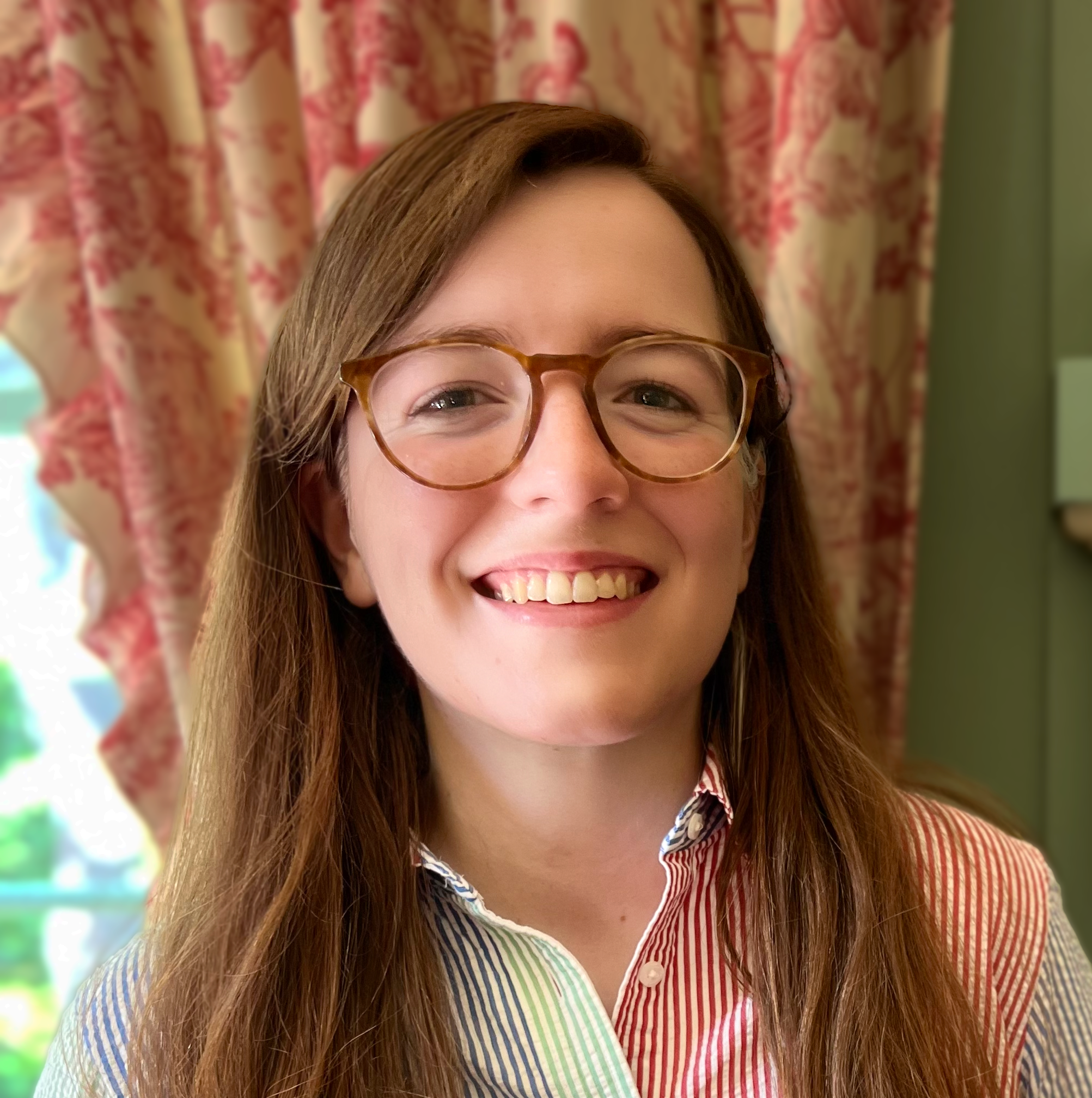The HIV/AIDS Epidemic and Public Broadcasting
1986-1988: The AIDS Special Program
Introduction
Coverage of the AIDS epidemic increased dramatically in 1987 after a shift in AIDS discourse and cases, which began to include higher numbers of heterosexual people. This is true of public broadcasting and other media: AIDS advertising campaigns like the HHS and CDC's "America Responds to AIDS" advertising campaign debuted in September 1987.39 During this period, we begin to see educational programs and documentaries about the disease airing nationally and locally on public broadcasting stations. Until this time, news reports and segments had been the primary media form for communicating information about the epidemic. The new, often hour-long programs featured varieties of panelists, including doctors, community organizers, government officials, and healthcare professionals involved in work surrounding the AIDS epidemic. The AIDS special program became one of the dominant genres of AIDS programming during the late '80s and '90s, in both local and national public broadcasts. In addition to broadcasting special programs, news programs like The MacNeil/Lehrer NewsHour and national documentary series like Frontline, POV, and NOVA covered AIDS more frequently.
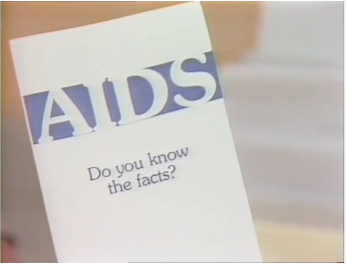 |
The programs in this section start with the surge in media coverage following actor Rock Hudson's public announcement that he had AIDS40 and indicate a more widespread fear in the general public of people with AIDS. The section provides an examination of a few moments in public broadcasting history from this period, beginning with a broadcast in March 1986 of the PBS documentary series Frontline. "AIDS: A National Inquiry," the first HIV/AIDS-related Frontline program, sparked national controversy around the filmmakers' treatment and representation of Fabian Bridges, a Black gay man living with AIDS. The next part looks at public broadcasting's coverage of legislative responses to the epidemic, including California Proposition 64, legislation regarding testing requirements and privacy, and congressional spending. Finally, the section ends with an analysis of local educational programming designed to dispel common myths about HIV/AIDS. Although gay men were at the highest risk of getting HIV, the programs rarely provided education specific to gay men. These educational programs focused on providing basic information about the disease.
Frontline Controversy
In March 1986, the PBS investigative documentary series Frontline aired "AIDS: A National Inquiry," one of the first national television programs that covered the HIV/AIDS epidemic. Notably, "AIDS: A National Inquiry" was not an educational documentary, but a documentary of controversy, partly of its own making. The Frontline program description reads:
Fabian Bridges, a homosexual prostitute, bragged he had sex with six partners a night and refused to stop even though he knew he had AIDS. In a special broadcast, Frontline first follows Bridges' tragic journey across the U.S. and later, a panel of national experts, led by Harvard Law School professor Charles Nesson, discuss how Americans should respond to this urgent public health issue.
The program featured the documentary "Fabian's Story," in which filmmakers followed Fabian Bridges, a Black gay man with AIDS who was experiencing houselessness in Cleveland, Ohio. The beginning of the program showed the isolation many people with AIDS experience: Bridges lost his job when his illness progressed, and then he was denied housing by his siblings and mother because of his diagnosis.
The controversy emerged mid-filming. When Bridges told filmmakers that he was sexually active and was not informing his partners that he had AIDS, they reported him to Cleveland public health officials. Council President George L. Forbes arranged a meeting with city and health officials on the matter.41 Local news media picked up the story, and Bridges became a well-known figure as officials and community members searched for him.
The documentary returned to Bridges after he relocated to Houston, where the county public health director sent him a letter warning that if he engaged in sexual activity, he would be denied medical care.42 In response to the growing media frenzy around Bridges, city health director Dr. James Haughton proposed a plan to quarantine sexually active AIDS patients. In addition, the Houston vice squad trailed Bridges for several days and tried to entrap him into "prostituting himself," according to the documentary. Bridges refused.
In the live panel discussion that followed the documentary, Diego Lopez, director of clinical services for the Gay Men's Health Crisis in New York, remarked, "I see the medical field failed him. The hospitals failed him…. Where were the patient advocates? Where were the social workers?" Lopez also identified instances of homophobia and racism that he saw in the documentary itself. Dr. Mervyn Silverman, president of the Foundation for AIDS Research (amfAR), charged that the documentary exploited Bridges for the "hot story," rather than providing him real support, such as psychiatric care.
After it aired, "AIDS: A National Inquiry" became a major topic of conversation in national news. Following Frontline's lead, news coverage characterized Bridges as a prostitute, and newspapers across the country denigrated Bridges in their descriptions of the documentary. An article in the Wall Street Journal called him a "gloomy, remote, acne-scarred stranger," and the Los Angeles Times wrote that he was "a miserable, wretched, uncaring victim-turned-victimizer who used his body as a lethal weapon."43
Gay activists protested the documentary, charging that it stoked homophobia and distracted from larger, systemic problems of the epidemic, such as stalled governmental response and homophobia in proposed legislation. Additionally, suspicion emerged around the production of the documentary and the verity of Bridges' statements. An article in the Bay Area Reporter, a San Francisco gay newspaper, stated that filmmaker Mike Sullivan of WCCO-TV, which produced "Fabian's Story" for Frontline, admitted that there was a "legitimate question" of whether Bridges had lied to filmmakers in exchange for money and housing.44 He also dispelled the myth that Bridges was a prostitute.
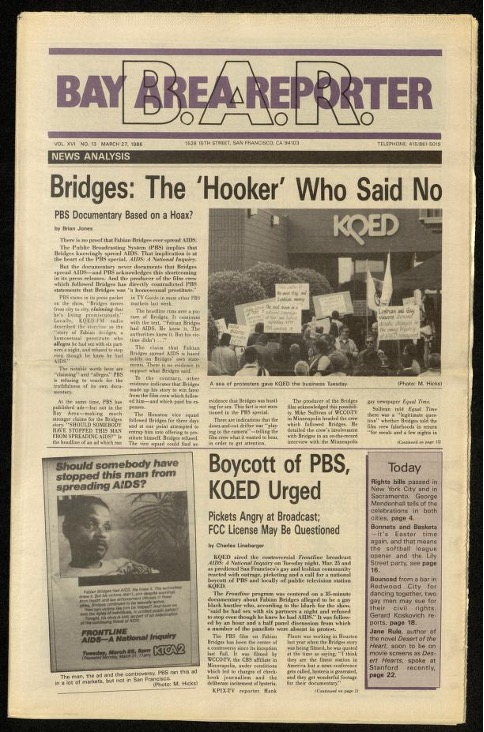 |
The Reporter issue also covered protests against KQED, the local PBS station. Roberto Esteves, chair of the San Francisco Telecommunications Policy Commission, said, "The channel 32 [KQEC, owned by KQED] issue is in some ways broader than this particular program because what we have been saying to KQED is that we want more gay programming and channel 32 is an underused resource. I feel like we've just had mud slung—media mud—and I think it's time to sling some back."
The Frontline controversy reproduced stereotypes associated with AIDS patients and the gay community's problems with representations in the media of people with AIDS. "Fabian's Story" contributed to the false media stereotype that Black sex workers with AIDS were knowingly having unprotected sex with white men and were major threats to public health.45 In the essay "Portraits of People with AIDS," art historian and AIDS activist Douglas Crimp argued that media representations of people with AIDS frequently exploit privacy, and their portrayal of "personal circumstances never includes an articulation of the public dimension of the crisis, the social conditions that made AIDS a crisis and continue to perpetuate it as a crisis."46 Crimp's article evaluated televised representations of people with AIDS in 60 Minutes and ABC's 20/20 as examples, but it spoke to problems of representation in media more broadly. His criticism that AIDS programming should address the "public dimension" and "social conditions that made AIDS a crisis" called for programming that examines homophobia and the government's failure to sufficiently provide research funding, social programs, and preventative educational campaigns. As we see in this exhibit, some public broadcasting programming has met this standard, but others have fallen short. While "AIDS: A National Inquiry" may have violated Bridges' privacy and contributed to media stereotypes by sensationalizing his "story," other programming in this exhibit attempted to explain to audiences not only the truths of the epidemic, but also particular legislative responses and failures. To Frontline's credit, the live panel discussion was an opportunity for experts to criticize the documentary. But for many in the gay community, that discussion did not make up for the damage wrought by its exploitative and unfair representation of Bridges and the absence of attention to the "public dimension" of the HIV/AIDS epidemic.
Covering Legislative and Policy Responses
Public broadcasting programs from this period include coverage of a wide variety of local and federal legislation related to HIV/AIDS. After the FDA licensed the first HIV test for screening blood supplies in 1985, legislation and debate often centered on testing—if/when it should be required, how results should be reported, if results should be confidential, and what role testing played in preventing the spread of the virus. The issue of privacy was critical not only to media representations of people with AIDS, but also to policy discussions.
In 1985, activists and followers of Lyndon LaRouche formed the Prevent AIDS Now Initiative Committee (PANIC) to propose California Proposition 64. LaRouche, an activist and conspiracy theorist associated with extremism, believed that HIV could be spread through mosquito bites and casual contact. Proposition 64 would have made AIDS and the condition of having HIV antibodies a reportable infectious disease under California state law. The larger effects of Proposition 64, if it passed, were unclear. PANIC members argued that health officials had shied away from aggressive anti-AIDS measures due to pressure from gay activists and the CDC. They wanted people with HIV antibodies to be removed from jobs that involved handling food and working in schools. Proposition 64 would have required people with HIV antibodies to be added to the preexisting confidential registry of people with AIDS, and it would have required members of the public to report anyone they knew who had tested positive, which many gay activists and public health officials believed would be a breach of patient privacy.47 These measures also could have required people who tested positive to quarantine. Surgeon General Koop spoke against the initiative, and researchers stated their concern that it would discourage people with AIDS from volunteering to participate in necessary studies.48
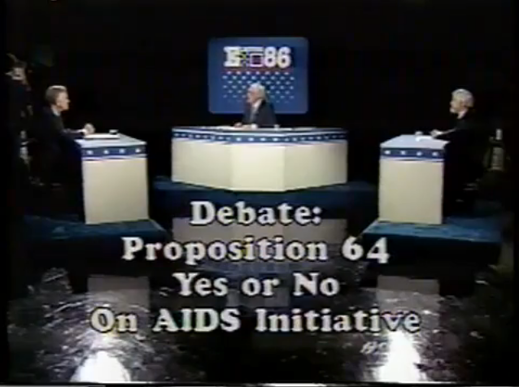 |
A few weeks before voting, KOCE-TV series Jim Cooper's Orange County aired a debate on the initiative. In favor of Proposition 64, the program featured William Dannemeyer, a Republican congressman for the 39th district in Orange County and the first politician to express support of the initiative. Rep. Dannemeyer suggested that any individual who tested positive for antibodies should be reported to public health officials. Dr. Mervyn Silverman, president of the Foundation for AIDS Research (amfAR), argued against Prop. 64. Silverman also had served as Public Health Director in San Francisco, where he controversially directed the closure of fourteen bath houses.49 In the program, Dr. Silverman reiterated concerns that the passage of Prop. 64 would lead to a steep decrease in volunteers for AIDS research and suggested that it would discourage people from getting tested. He also spoke strongly against "the epidemic of fear" to which, he asserted, PANIC's initiative contributed. Silverman argued that "people like Congressman Dannemeyer, who are so opposed to homosexuals and the homosexual lifestyle, would like to see them constrained, isolated, [and] separated, which will help in no way to reduce the spread of this disease."
The proposal also was examined in a MacNeil/Lehrer NewsHour segment hosted by Peter Graumann from KCET in Los Angeles. The segment included parts of a conversation between LaRouche and reporter Jeff Goldman, footage from demonstrations against the initiative, and comments from Rep. Dannemeyer, Dr. Mark Madsen of the California Medical Association, and Dr. Shirley Fanin, Head of Communicable Disease Control for L.A. County. LaRouche told Goldman that citizens had to demand more from the government "because we have a massive cover-up through the international public health mafia, which is orchestrating false statements by local medical institutions and others, who are telling what they know to be lies, because if they don’t their money will be cut off." The NewsHour's comprehensive coverage of LaRouche and PANIC's proposals, alongside activist and public health officials' opposition, offered a clear image of what Dr. Fanin called "an impossible thing to do." PANIC would never see its initiative come to fruition; on the 1986 ballot, Proposition 64 was defeated with 70% of voters against it.
Mandatory HIV testing was the subject of another legislative proposal put forward during this period. In 1987, The MacNeil/Lehrer NewsHour reported on proposals to target certain individuals for HIV testing. Those targeted included marriage license applicants, hospital patients, pregnant women, and venereal disease patients. Kristine Gebbie, chairman of the AIDS Committee of the Association of State and Territorial Health Officials, stated on the program that public health officials were looking for a "funnel" for testing people who are likely to test positive, rather than testing the general population. Targeting people who apply for marriage licenses and hospital patients, she argued, would not be particularly useful. This proposal also did not succeed.
Legislative proposal debates frequently addressed issues of medical confidentiality for people with AIDS. In October 1988, Congress passed a bill that increased funding for AIDS research, education, and treatment by $1 billion.50 The bill, which was signed seven years after the first MMWR on pneumonia in gay men, was blocked by North Carolina Senator Jesse Helms for almost two weeks. He insisted the Senate remove the House-passed confidentiality protections for people who tested positive for HIV antibodies and eventually the change was made. Helms also demanded that educational materials and campaigns not "promote or encourage homosexuality" or include language that suggested homosexuality was "normal," "natural," or "healthy." The Senate reached a compromise, and the final bill stated that educational materials could not be "designed to promote or encourage, directly, intravenous drug abuse or sexual activity, homosexual or heterosexual."51 In an episode of Minnesota Public Radio's Midday, Rep. James Oberstar answered a call-in question about his support of the bill when it was being negotiated. He responded that Helms's other proposed amendment, that people with AIDS be forbidden from handling food, "adds to public hysteria about this issue."
The Reagan administration had many internal disagreements over how to respond to the epidemic, which had become highly politicized. HHS, for example, argued against mandatory testing, while White House aides and Education Secretary William Bennett supported it. NewsHour coverage from May 15, 1987, included a panel discussion between NewsHour correspondent Judy Woodruff, Steven Roberts, New York Times White House correspondent, and Fred Barnes, senior editor of the New Republic. Roberts claimed that Reagan, who had advocated for abstinence to prevent the spread of HIV, had "a vested interest in the moral aspect" of the epidemic. Barnes, however, noted that Reagan had supported Surgeon General Koop's report, which encouraged condom usage. He argued, "Basically, the President hasn't made up his mind. He hasn't set a policy." The discussion provided a close examination of culture wars and power dynamics within the conservative Reagan administration.
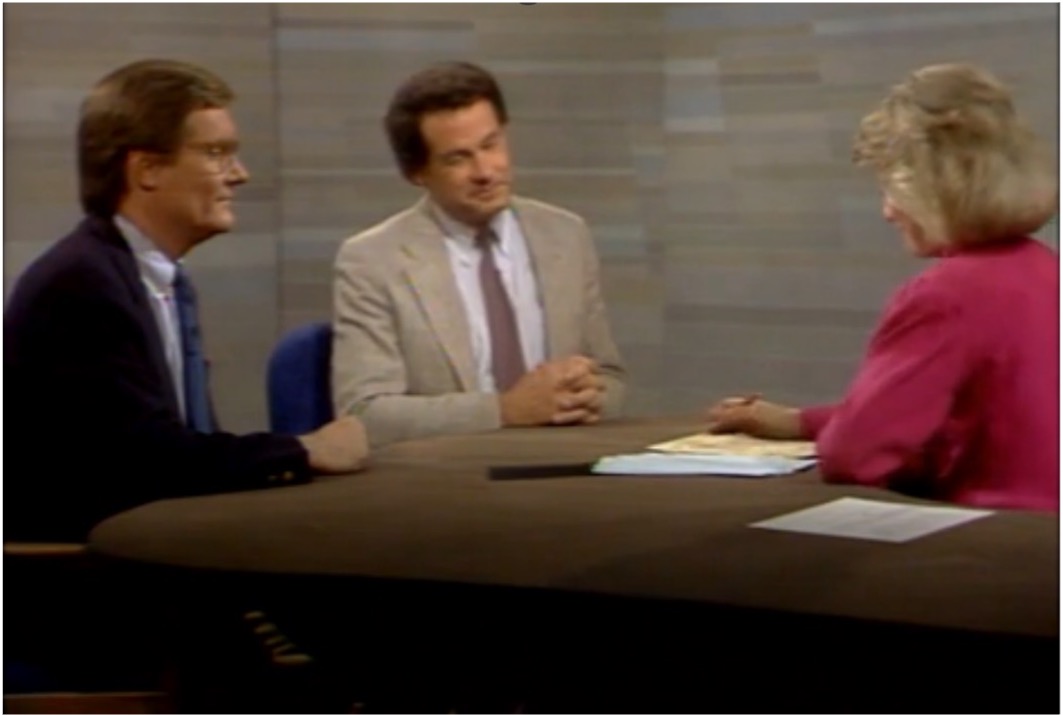 |
Woodruff reported that if the administration adopted the U.S. Public Health Service recommendation that all people immigrating to the U.S. must be tested for HIV/AIDS, AIDS would be added to the U.S. immigration medical screening process. The addition, which was adopted one month after this broadcast, disqualified people from becoming U.S. residents if they were HIV positive.52 Woodruff also reported on AIDS legislation put forward by Sen. Edward Kennedy, who was shown criticizing the Reagan administration. Kennedy claimed the Reagan administration had "offered nothing but ideological disputes and paper policies" throughout the course of the epidemic.
Public broadcasting coverage offers us a closer look at a few of the numerous local and federal legislative responses to the epidemic. The debates presented in the coverage of California Proposition 64, sex education, the addition of HIV to the U.S. immigration screening process, and the $1 billion AIDS bill help us better understand the motivations behind legislative proposals, the culture wars that undergirded such proposals, how misinformation about HIV and AIDS was spread, and what public servants were willing to do in response to the raging epidemic.
Local Educational Programming
Homophobia continued to inflect HIV/AIDS-related legislation, media coverage, and debates broadcast on public television and radio. In an effort to fairly present these conversations, public broadcasting stations aired educational programs that provided factual information about the epidemic and sometimes featured panels of experts, who answered call-in questions about HIV and AIDS. The programming in this section shows a range of common misunderstandings about HIV/AIDS and features a number of well-known HIV/AIDS specialists. As with other educational campaigns, these programs often did not focus on providing information specific to gay men, who were most at risk, but to the general population.53
One exception was PBS Wisconsin’s 1986 broadcast, Survival Kit: For Men at Risk in the Age of AIDS. The program opened with music and gay men dancing in a bar. In a voiceover, host Jay Jones narrated, "From New York to California, and in all the states between, gay and bisexual men, as well as intravenous drug users, are now living in the age of AIDS."
 |
The program presented interviews with several people on the topic of antibody tests. Interviewees included Doug Johnson of the Brady East Sexually Transmitted Disease Clinic in Milwaukee, Katy Morrison from the Wisconsin Department of Health, Dr. Dennis Maki from University of Wisconsin Hospitals, and several gay men who were identified by first name only. Morrison underlined the importance of confidentiality and anonymity at clinics where the antibody test was being administered: "There are some people who might be frightened at going to the doctor's, because they may be afraid that their name will end up on some sort of list, and it could result in them losing their job, or losing their apartment, or something like that." Other interviewees explained that anonymity was necessary to encourage testing and protect individuals who tested positive.
Survival Kit had a particular audience. This relatively early program in public broadcasting's coverage of AIDS aimed to educate sexually active people, especially gay men, on up-to-date HIV/AIDS research, testing availability and confidentiality in Wisconsin, and safe sex practices. This specific audience contrasted with that of many other HIV/AIDS educational programs, which were mostly directed toward the general public.
The New Jersey Network produced the documentary On the Trail of a Killer in 1988 and followed it with New Jersey AIDS Helpline, a live, two-hour educational program that included interviews with Dr. Anthony Fauci, director of the National Institute of Allergies and Infectious Diseases (NIAID), and Dr. Luc Montagnier, one of the two scientists who discovered HIV. An expert panel that answered call-in questions featured Dr. Mathilde Krim of the American Foundation for AIDS Research; New Jersey Health Commissioner Dr. Molly Coyne; pediatric infectious disease specialist, Dr. James Oleske; and adolescent AIDS expert Dr. Robert Johnson. The New Jersey AIDS Helpline segment was simultaneously broadcast across 50 New Jersey radio stations.54 These programs were a part of a larger week-long campaign of AIDS-related programming from NJN.
 |
On the Trail of a Killer explained the increasing pressure on researchers to make treatments for AIDS available and clarified activists' criticisms of pharmaceutical companies and researchers like Dr. Fauci. On this criticism, Fauci said in an interview, "There's a lot of perception that people mix up policies versus science, educational versus research, et cetera, but if you're talking just about the science and the biomedical research effort, that has been very rapid, and the results, I think, are proof of the pudding. More has been learned about this disease in the few years since we know about the virus itself—the molecular biology, treatments, and early testing of vaccines—in a speed that's unprecedented."
Dr. Fauci talked about Azidothymidine, or AZT, the first drug approved by the FDA to treat HIV/AIDS. AZT was developed by Burroughs Wellcome Pharmaceuticals to treat cancer, but was unsuccessful. When scientists and pharmaceutical companies wanted to put forward a treatment for HIV/AIDS, they revisited failed drugs, and AZT was one that seemed to be effective for treating HIV.55 Burroughs-Wellcome then applied for a patent, making it the only company that could produce the drug. A nucleoside analog reverse-transcriptase inhibitor (NRTI), AZT inhibits the replication of HIV. AZT, like other cancer treatments, is toxic and has many side effects, including fatigue, nausea, vomiting, and some other more life-threatening but rare conditions. On the Trail of a Killer paired Dr. Fauci's commentary about AZT with an interview with Tony Lopilato, a person with AIDS who took AZT every four hours, in addition to other drugs that treated opportunistic infections. Lopilato discussed the dilemma of choosing whether or not to take drugs that made him sick. He told the interviewer, "It's a matter of quality of life. If you're going to be nauseous all the time, if I'm going to spend my whole life in bed, well, I don’t know if that's worth going on."
The program looked at other drugs being tested, like dideoxycytidine, another NRTI, and arguments around the use of placebos in research for HIV/AIDS treatments. Dr. Fauci defended the use of placebos, while Lopilato, like many people with AIDS and many AIDS activists, argued that giving placebos to people with AIDS was cruel. Placebo studies had been the subject of debate throughout the epidemic, and the activist group ACT UP protested the practice, in addition to criticizing researchers for the amount of time taken to approve treatments. T. E. Haigler, vice president of Burroughs Wellcome, talked in the program about the seven-month production timeline and the high cost of producing AZT.
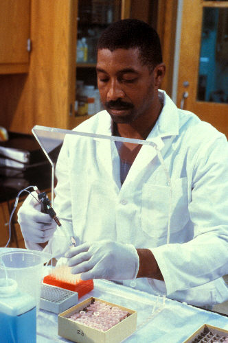 |
The program also included an interview with Dr. Mathilde Krim, founding co-chair of the American Foundation for AIDS Research (amfAR). She criticized the focus by the government and researchers on AZT, in addition to expressing concern that the price of HIV/AIDS drugs would limit access. She said, "We are going to have to decide if there is an entitlement to life and to life-saving drugs or not in this country." Dr. Krim also suggested that the government might regulate drug prices set by pharmaceutical companies, something that the U.S. had never done before. While the federal government did not intervene, Burroughs Wellcome reduced the price of AZT by 20% in 1989, after intense pressure from AIDS activists.56
Other segments included the prescription of AZT for children with HIV/AIDS; an interview with one of the researchers who discovered HIV, Luc Montagnier; an interview with John Belskus, AIDSARC Vigil Founder; and one with John James, author of AIDS Treatment News, which detailed news related to HIV/AIDS research and treatments biweekly. The program provided a close look at the process of drug development and approval for viewers who likely did not understand how HIV/AIDS drugs functioned and how drugs were approved. It also made clear that while scientists worked on developing pharmaceuticals and the FDA assessed drugs for approval, people with AIDS advocated for themselves by demanding more treatments and a streamlined drug approval process, and by sharing knowledge of alternative therapies that might help.
In 1987, the KUT Radio series In Black America examined AIDS in the Black community. Host John L. Hanson Jr. interviewed Charles Wallace and Dorothy Gibson from the Texas Department of Health. The program explained the basics of the epidemic, rates of infection in Texas, and test result confidentiality. Wallace and Gibson also answered common questions about HIV/AIDS and spoke about particular concerns within the Black community, such as testing confidentiality, infection rates among IV drug users, and preventative education. Part Two of "AIDS in the Black Community" covered AIDS legislation, mandatory testing, and issues of patient privacy. Dr. Paul Bristol, a physician in Texas, urged listeners to take the HIV/AIDS epidemic seriously, especially as rates among Black Americans were growing.
HIV/AIDS had become a major issue in minority communities. Another In Black America episode from 1988 examined how, despite the common misconception that AIDS was a "white gay disease," Black and Hispanic populations were at disproportionately higher risk for HIV infection. At the time of the radio broadcast, half of all women with AIDS were Black as were more than 60% of all babies born with AIDS. The episode included recordings from a panel on AIDS in the Black community hosted by the National Association of Black Journalists. Panelists included Dr. Reed V. Tuckson, Commissioner of Public Health for the District of Columbia; Dr. Herbert W. Nixon, Director of the Office of Minority Health within the HHS; Dawn Edwards, Executive Director of the National Minority AIDS Council; Joe Davison, journalist at the Wall Street Journal; and Robin Smith, Midday co-anchor and news reporter in St. Louis.
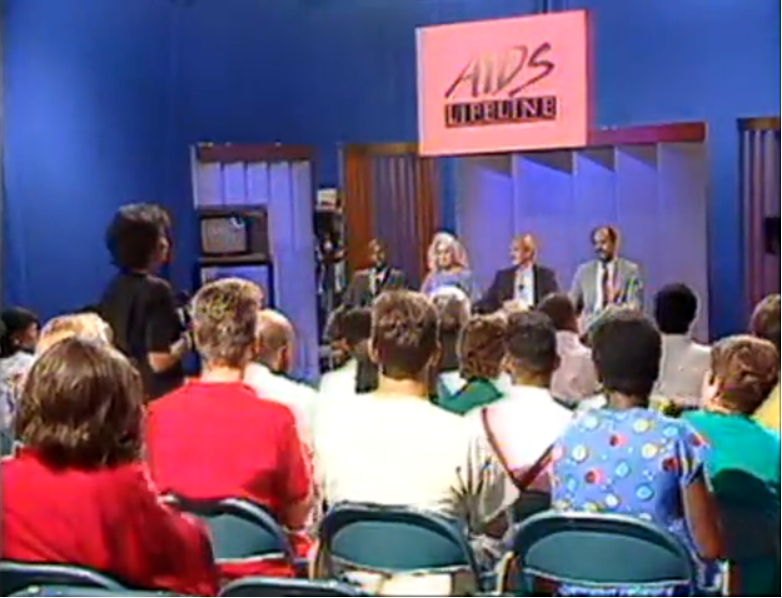 |
The 1988 AIDS Lifeline program, produced by Howard University's WHMM in Washington, D.C., featured a panel discussion hosted by Carol Randolph between community leaders who worked on the local epidemic response. Panelists included James McLaurin, a volunteer for the Whitman-Walker Clinic who was living with AIDS; Patricia Kelly, training director of the Northern Virginia AIDS Ministry; David Brubeck, founder and executive director of the Maryland AIDS Foundation; and Dr. Wayne Greaves, medical director in the Howard University Hospital Infectious Disease department. The program did not assume its audience knew any factual information about HIV/AIDS. Randolph's opening question set the tone of this educational program: "Just how dumb are we when it comes to AIDS?"
AIDS: Why Take Chances? (WHA-TV, Madison, Wisconsin, March 2, 1988) addressed young people's concerns about AIDS. It included written-in questions, an informational quiz, a Q&A with panelists, and condom education, as well as information about testing reliability, drug effectiveness, and other topics. The host and panelists frankly discussed sex, which was rare in television coverage of HIV/AIDS, but was something that many activists and health officials recommended.57 Panelists Dr. Jim Vergeront, Supervisor of the Department of Health and Social Services AIDS Program; Sue Dietz, Executive Director of the Milwaukee AIDS Project; Vickie Wilson, Teen Peer Educator from Planned Parenthood of Milwaukee; and Dr. James Allen, Assistant Director for the AIDS Program at the CDC, answered questions that viewers called into the program either on-air or privately. On-air questions evidenced common misunderstandings about AIDS and concerns about contact with people with AIDS. For example, one viewer asked the panel why the names of teachers with AIDS were not made publicly available "to protect the children," just as the results of teachers' required tuberculosis testing is in the public record. Dr. Vergeront responded that tuberculosis could be spread through casual contact, whereas HIV could not. He also underlined the importance of confidentiality for people with AIDS and people who are HIV-positive, because they should feel safe getting tested "without the fact that they're infected—their name spread in the newspaper, and all sorts of people in their workplace know that they're infected, especially in settings where there's just no other risk to the other individuals." When asked if progress had been made in curbing discrimination, Dietz said that there were still instances of people with AIDS being rejected by their families, fired from their jobs, and evicted from their homes.
KUNM in Albuquerque, New Mexico, devoted an episode of Focus on Education to "Legal Rights of Children with AIDS." The program consisted of a discussion with Dr. Ruth Luckasson, a lawyer and Associate Professor of Special Education at the University of New Mexico who also served on the American Bar Association Coordinating Committee on AIDS. The conversation covered legal issues relating to children with HIV/AIDS, who made up 2% of people with AIDS. Topics included strategies for communicating basic facts of HIV/AIDS, including HIV/AIDS in sex education curricula and children with AIDS in schools, which was a common concern among parents in the 1980s and 1990s. Dr. Luckasson responded to this concern by stating that there were no known cases of children spreading HIV in schools, because transmission occurs through blood and semen. Dr. Luckasson also noted that surveys indicated that most people believed schools should have AIDS education, but the explicitness of that education was debated. She argued that sex and drug risks related to HIV/AIDS should be "part of any school's good family living sex education curriculum," adjusted for age appropriateness.
